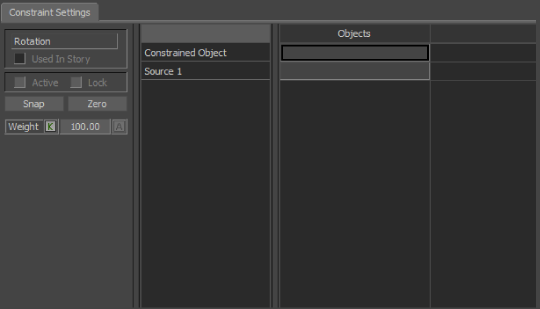Rotation constraint settings
The Rotation constraint transfers the rotation between two objects.

Rotation constraint
The Rotation constraint requires the following objects:
Constrained object
An asset, model, or other object whose rotation is based on the rotation from a single source object. Also known as the “Child” object.
Source
Sends rotation information to the constrained object. You can have multiple source objects for this constraint. Also known as the “Parent” object.
Rotation constraint settings in the Properties window
The following Rotation constraint settings are found only in the Properties window when the constraint is selected in the Scene browser:
Rotation X/Y/Z
Use these fields to offset the constrained object from the Source object(s). You can set key animation on any of these settings.
These fields are disabled if the Lock option is activated.
Constraint Axes
Activating or disabling these axes affects whether the constrained object is affected by the source objects’ movement in this direction.
| Axis | Description |
|---|---|
| Affect X | When active, the constrained object moves along the X-axis when the source object is rotated. |
| Affect Y | When active, the constrained object moves along the Y-axis when the source object is rotated. |
| Affect Z | When active, the constrained object moves along the Z-axis when the source object is rotated. |
(SourceObject).Weight
Use this setting to give different amounts of influence to source objects.
You no longer have to drag the same object in the source field to create weighting with this setting. If you are working on an earlier version of the positions constraint where this has been done, this is compensated.
